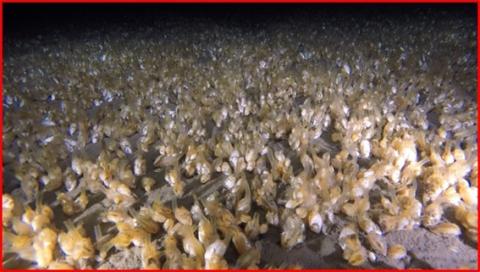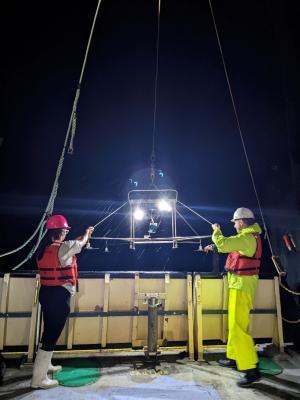From July 16-27, the R/V Lake Guardian will sample stations throughout Lake Michigan as part of the 2025 Lake Michigan Benthic Survey designed to monitor and map the distribution of benthic (bottom-dwelling) organisms in Lake Michigan.
Scientists will collect underwater video footage and “grab” samples of the lake bottom sediment that will allow the science team to estimate the abundance of benthic species and characterize benthic habitat, with a special emphasis on mapping the distribution of invasive Dreissena (Quagga and Zebra) mussels.
Benthic organisms, including amphipods, mollusks, and insect larvae, are indicators of water quality and many species, such a native Diporeia amphipods, are an important food source for preyfish which, in turn, support top predator fish in the Great Lakes. Invasive Dreissena mussels however, have negative impacts on the heath of native species populations. With the Great Lakes fisheries collectively valued at over $5.1 billion annually, it is important to monitor how Dreissena mussels are altering the base of the Great Lakes food web that supports these important recreational and commercial fisheries.
Dreissena mussels have significantly altered the Lake Michigan ecosystem, altering water quality and habitats. They filter large amounts of plankton, impacting the food web, nutrient cycling and availability, and water clarity. These changes have impacted fish populations and led to increases in nuisance algae in the lake. Dreissena mussels also cause damage to water tanks, pipes, screens, and other industrial or recreational structures, resulting in economic impacts.
Collecting data on the health of the benthic community and abundance and spread of invasive species helps inform environmental managers of the status of Lake Michigan’s food web health and changes in invasive mussel populations. This year’s survey results will be compared with past surveys to determine if Dreissena mussels and Diporeia abundance and distribution have changed since the last lakewide Lake Michigan benthic survey conducted by EPA in 2021 (see Fig. 1).

Joining scientists from EPA’s Great Lakes National Program Office to conduct the survey are scientists from SUNY Buffalo State University, the National Oceanic and Atmospheric Administration’s Great Lakes Environmental Research Laboratory, Wright State University, University of Wisconsin-Milwaukee, SUNY Brockport, and Cornell University.
EPA’s work aboard the R/V Lake Guardian is funded through the Great Lakes Restoration Initiative and is designed to assess the health of all five Great Lakes to meet EPA's obligations under the Clean Water Act. This work is aligned with EPA's Pillar #1 in support of restoring and protecting Great Lakes water quality so that it can be used for drinking water, fishing, recreation and other uses. To learn more about monitoring in the Great Lakes, please visit EPA’s website.



